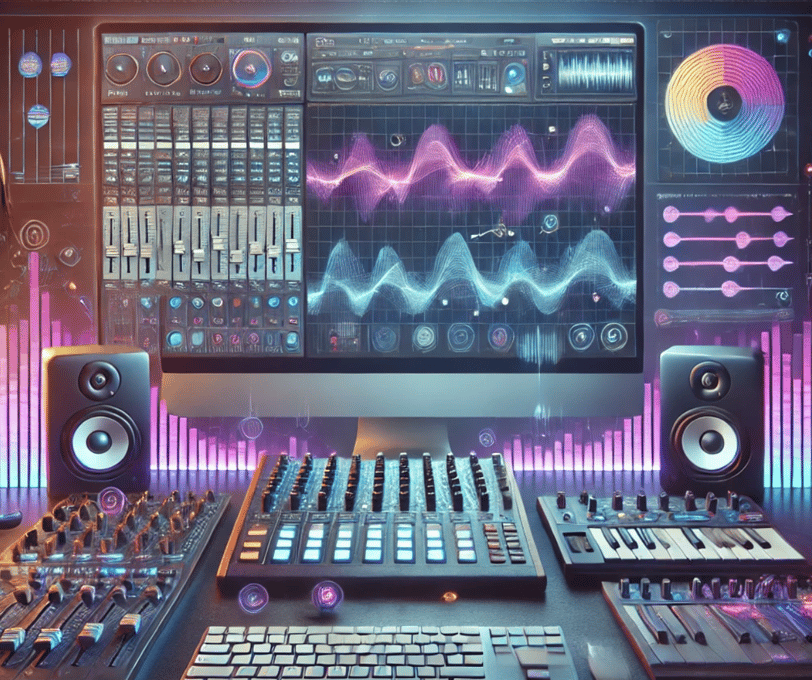The Art of Mixing
Essential Techniques for Aspiring Producers
9/11/20243 min read


In the world of music production, mixing is where the magic happens. It's the process that transforms a collection of individual tracks into a cohesive, polished song. For aspiring producers and engineers, mastering the art of mixing can be the key to creating professional-sounding music. In this post, we'll dive deep into some essential mixing techniques that can elevate your productions to the next level.
1. Gain Staging: The Foundation of a Good Mix
Before you start adjusting EQs or adding effects, it's crucial to set proper gain levels for each track. Gain staging ensures that you have enough headroom to work with and prevents distortion.
Start by setting your faders to unity gain (0 dB)
Adjust the input gain of each track so that its peak level is around -18 to -12 dBFS
This gives you plenty of headroom and allows for more natural-sounding compression and saturation later in the mix
2. EQ: Carving Out Space in the Frequency Spectrum
Equalization is one of the most powerful tools in mixing. It allows you to shape the tonal characteristics of each element and create space in the mix.
Use high-pass filters to remove unnecessary low frequencies from non-bass elements
Cut rather than boost: if an element needs more presence, try cutting competing frequencies in other tracks
Be subtle: small changes of 1-3 dB can often make a big difference
Use parametric EQ for precision adjustments and shelving EQ for broader tonal shaping
3. Compression: Controlling Dynamics
Compression helps to even out the volume of a track and can add character and cohesion to your mix.
Start with a low ratio (2:1 or 3:1) and adjust the threshold until you see 2-3 dB of gain reduction
Use faster attack times for transient control and slower attack times to preserve punch
Adjust the release time to match the rhythm of the track for a more natural sound
Don't over-compress: preserve some dynamic range to keep the music lively
4. Stereo Imaging: Creating Width and Depth
A good stereo image can make your mix sound bigger and more immersive.
Keep low-frequency elements (kick, bass) centered
Use panning to create space for each element in the stereo field
Experiment with stereo widening techniques on background elements or effects returns
Be careful not to overdo stereo processing, as it can cause phase issues and reduce mono compatibility
5. Reverb and Delay: Adding Space and Dimension
These time-based effects can add depth and interest to your mix, but they need to be used judiciously.
Use pre-delay on reverb to maintain clarity and separation
Consider using shorter reverb times for faster songs and longer times for ballads
Create depth by using different reverb sizes for different elements
Use delay instead of reverb on some elements to create space without washing out the mix
6. Automation: Bringing Your Mix to Life
Automation allows you to create movement and interest throughout your song.
Automate volume to highlight important elements at different parts of the song
Use filter sweeps to create builds and transitions
Automate effect parameters (like delay feedback) to create moments of interest
Don't be afraid to make bold automation moves - they can often be what makes a mix exciting
7. Reference Tracks: Your North Star
Always compare your mix to professional references in the same genre.
Use reference tracks to check your overall tonal balance
Compare the stereo width and depth of your mix to the references
Check how your mix translates to different playback systems, just like the reference tracks
8. The Mix Bus: Pulling It All Together
Subtle processing on your mix bus can help glue all the elements together.
Start with light compression (1-2 dB of gain reduction)
Use gentle EQ to shape the overall tone of the mix
Experiment with saturation to add warmth and character
Be very subtle - a little goes a long way on the mix bus
9. Take Breaks and Trust Your Ears
Mixing is as much about decision-making as it is about technical skill.
Take frequent breaks to avoid ear fatigue
Listen to your mix on different systems and in different environments
Trust your instincts - if something sounds good to you, it probably is good
10. The Most Important Rule: There Are No Rules
While these techniques provide a solid foundation, remember that mixing is an art form. Don't be afraid to experiment and break the rules if it serves the song.
Mixing is a lifelong journey of learning and refining your craft. Every mix presents new challenges and opportunities to grow as a producer. The techniques we've covered here are just the tip of the iceberg.
Want to dive deeper into the world of music production and stay up-to-date with the latest mixing techniques and industry insights? Sign up for our newsletter! Each week, we'll deliver expert tips, gear reviews, and exclusive tutorials straight to your inbox. Don't miss out on the chance to take your production skills to the next level - join our community of passionate music makers today!
Sign up below and get your FREE Ebook " From Pen to DAW: Mastering Music Composition in the Digital Age"
